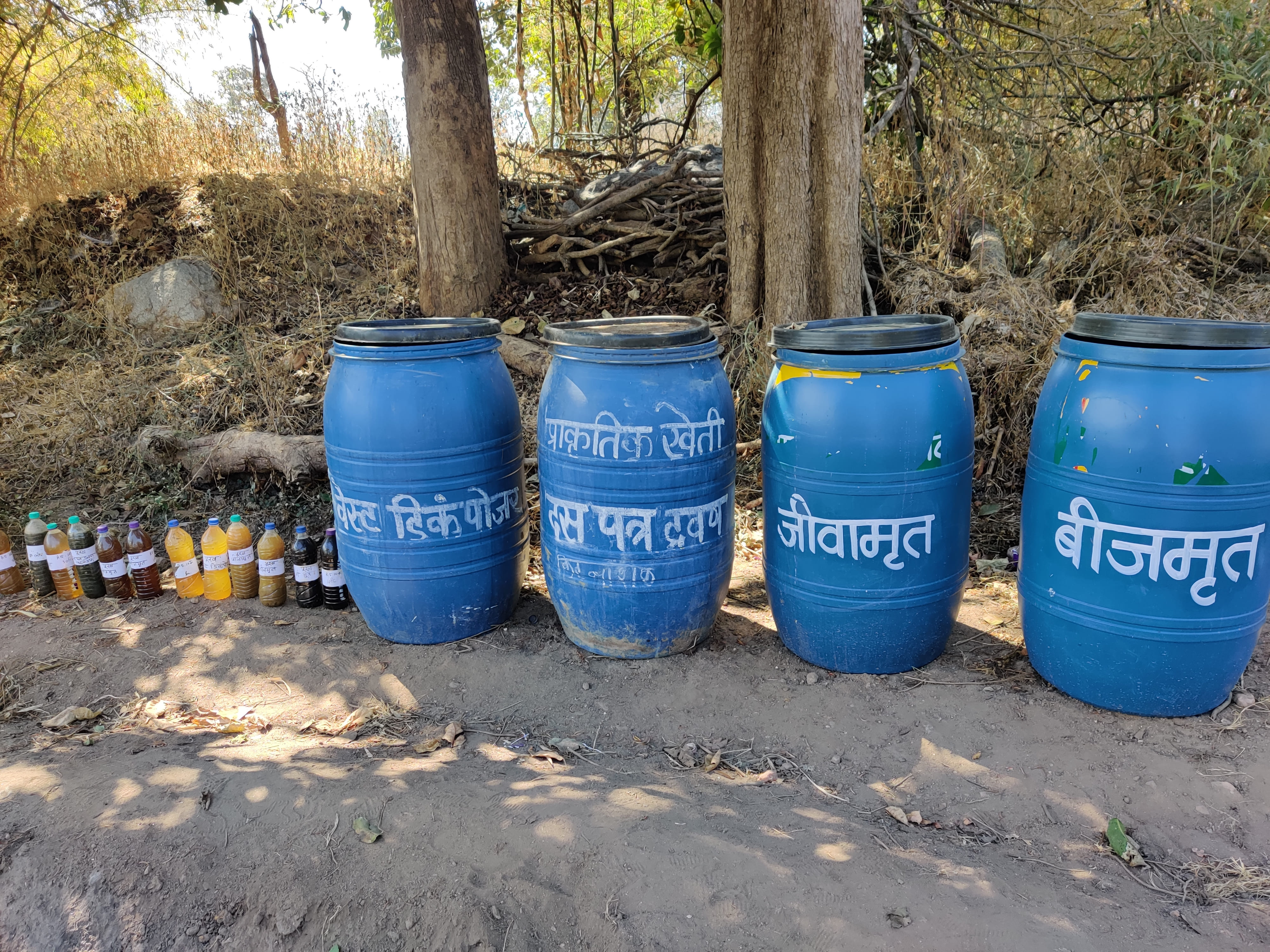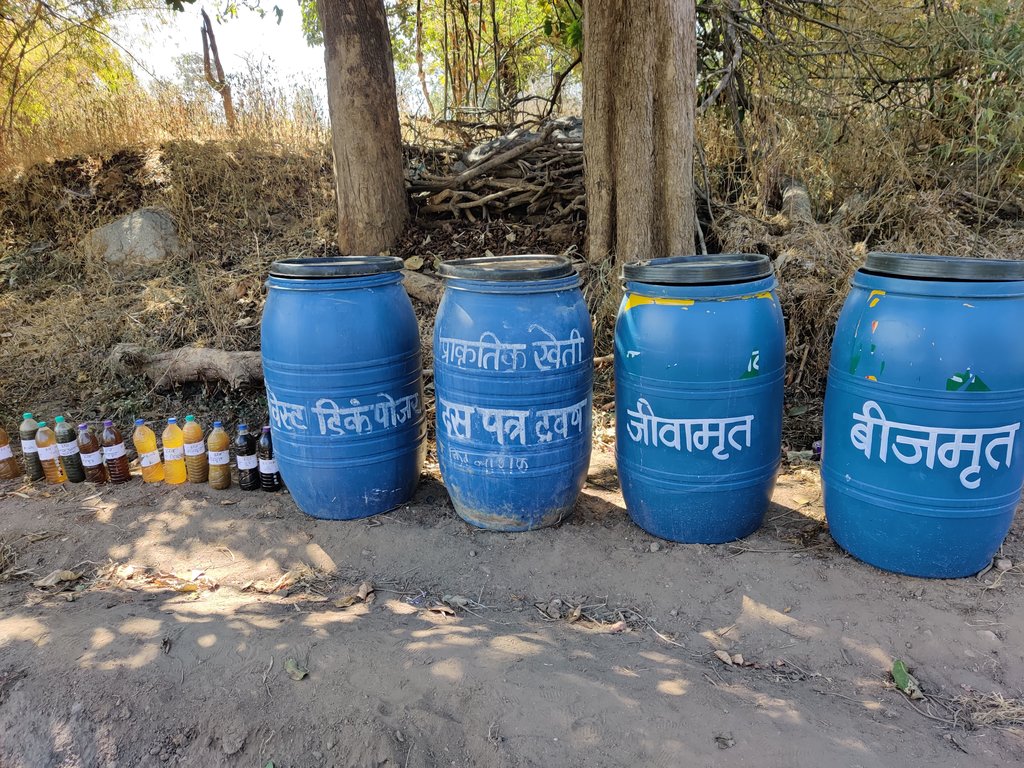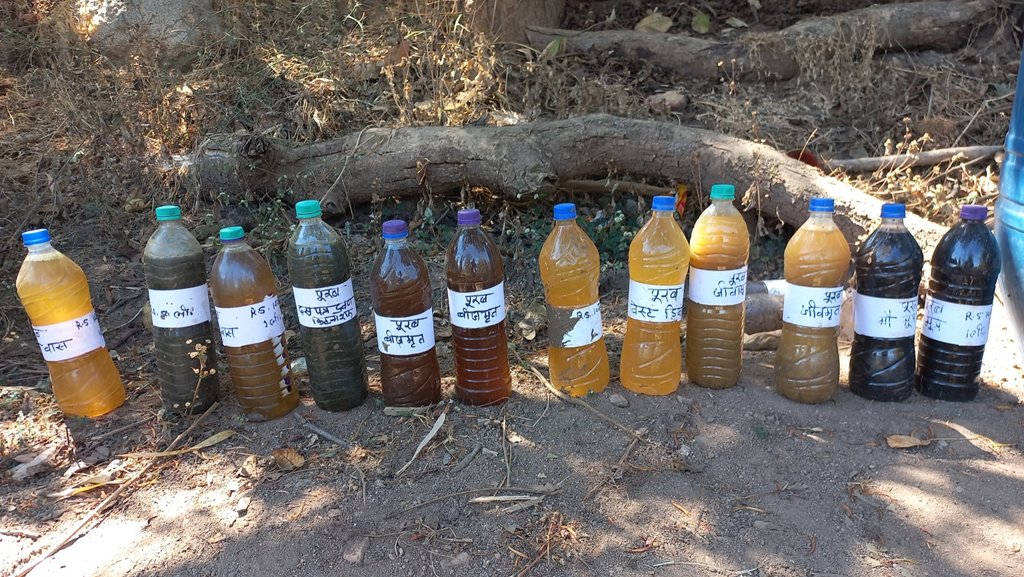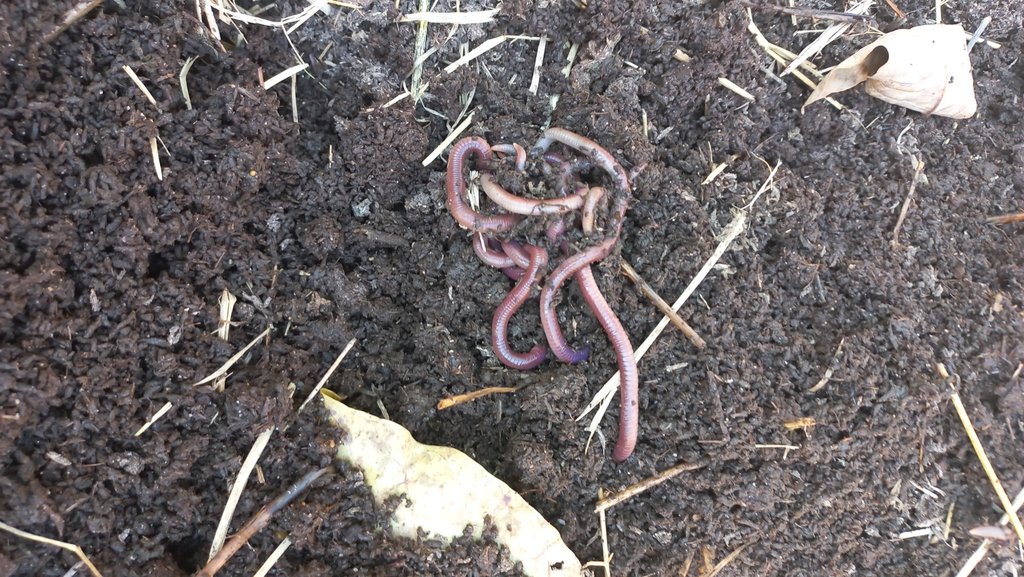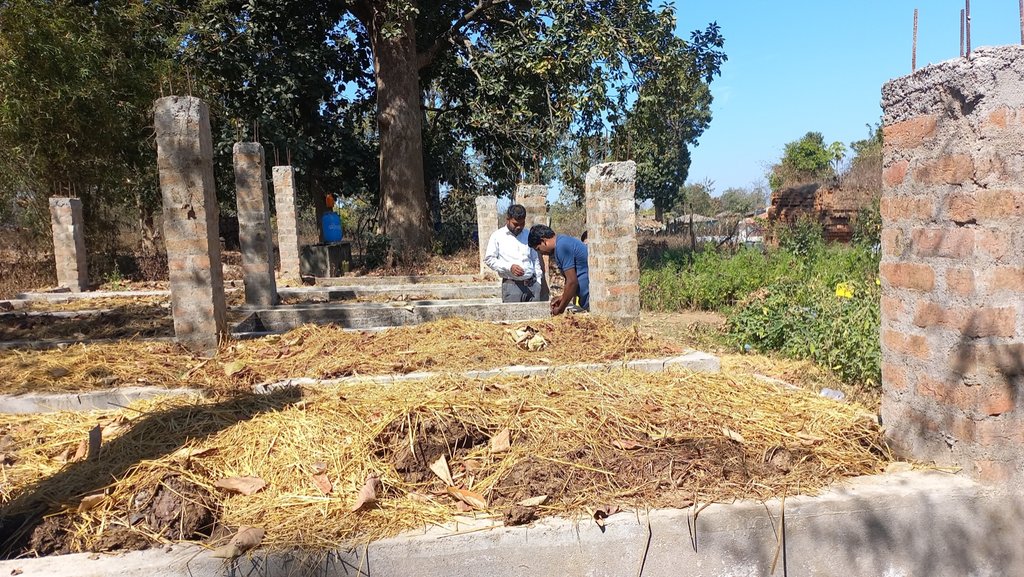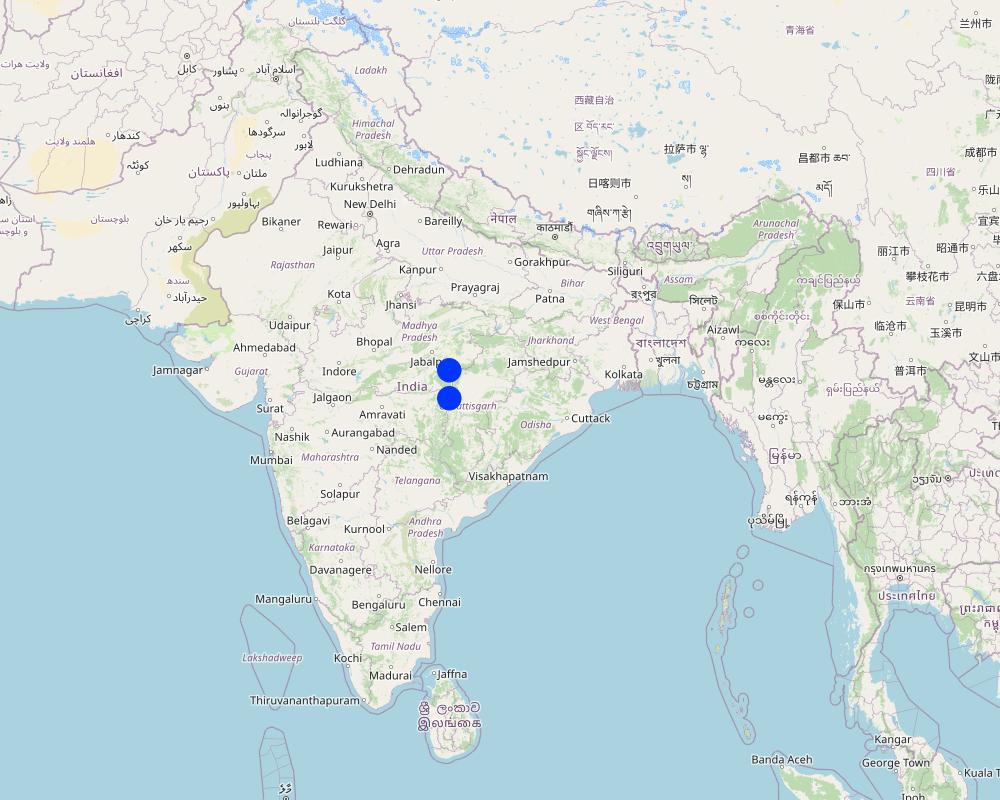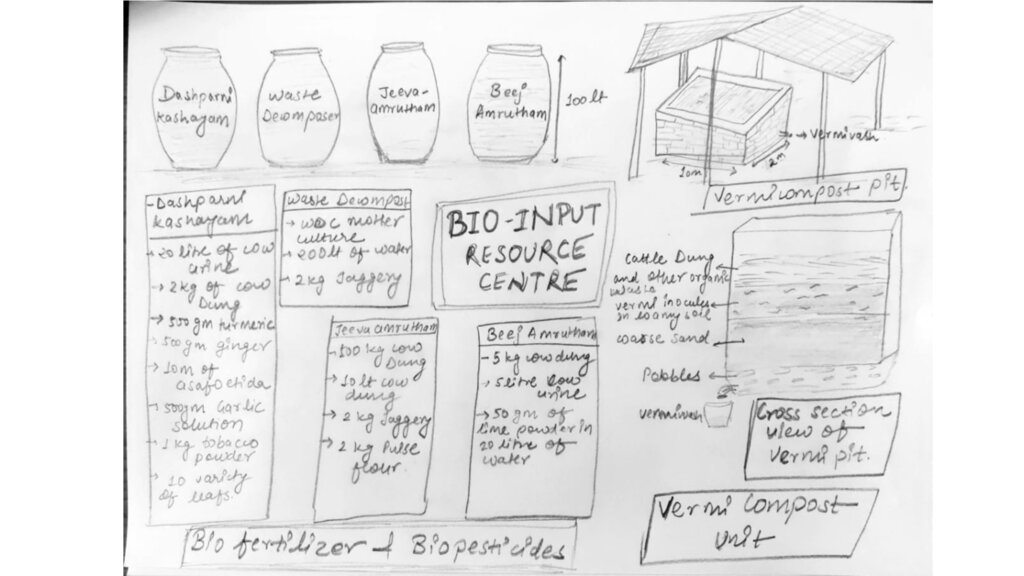Preparation of Bio-Inputs such as Vermicompost, Biofertilizers, and Biopesticides [印度]
- 创建:
- 更新:
- 编制者: Santosh Gupta
- 编辑者: Noel Templer, Stephanie Katsir, Kim Arora, Tabitha Nekesa, Ahmadou Gaye, Siagbé Golli
- 审查者: Udo Höggel, Joana Eichenberger, Sally Bunning
Kechua khaad, Beej Amrutham, Jeevamrutham, Dashparni and compost
technologies_6695 - 印度
- Preparation of Bio-Inputs such as Vermicompost, Biofertilizers, and Biopesticides: June 25, 2023 (inactive)
- Preparation of Bio-Inputs such as Vermicompost, Biofertilizers, and Biopesticides: Sept. 14, 2023 (inactive)
- Preparation of Bio-Inputs such as Vermicompost, Biofertilizers, and Biopesticides: April 17, 2024 (public)
查看章节
全部展开 全部收起1. 一般信息
1.2 参与该技术评估和文件编制的资源人员和机构的联系方式
有助于对技术进行记录/评估的项目名称(如相关)
Soil protection and rehabilitation for food security (ProSo(i)l)有助于对技术进行记录/评估的机构名称(如相关)
Deutsche Gesellschaft für Internationale Zusammenarbeit (GIZ) - 德国有助于对技术进行记录/评估的机构名称(如相关)
CIAT International Center for Tropical Agriculture (CIAT International Center for Tropical Agriculture) - 肯尼亚有助于对技术进行记录/评估的机构名称(如相关)
Ecociate Consultants (Ecociate Consultants) - 印度1.3 关于使用通过WOCAT记录的数据的条件
编制者和关键资源人员接受有关使用通过WOCAT记录数据的条件。:
是
1.4 所述技术的可持续性声明
这里所描述的技术在土地退化方面是否存在问题,导致无法被认为是一种可持续的土地管理技术?:
否
2. SLM技术的说明
2.1 技术简介
技术定义:
Bioresource Center (BRC) is an enterprise model to promote the preparation and commercialization of bio-inputs to help farmers adopt natural and sustainable agriculture practices. The bio-inputs and composting material under such models are prepared using locally available material at very affordable prices.
2.2 技术的详细说明
说明:
Bioresource Center (BRC) is a community-led enterprise to produce bio-inputs and compost from locally available bioresources for improving soil health and fertility, managing pest and disease, and meeting the nutrient requirement for the crops. BRCs have been envisaged as a potential enterprise solution to meet the requirements of small and marginal farmers who do not have time and resources to make their own bio-inputs and composting material. Such farmers can purchase the bio-inputs at very affordable prices from the BRCs being operated by either individual entrepreneurs or community-based institutions of male and female farmers.
Essentially it is an enterprise-led platform that can create the necessary conditions to scale the adoption of better farming practices. The technology for bioresource units is applied in both natural and human environments to promote sustainable agriculture and improve livelihoods in rural communities. The establishment and maintenance of a bioresource unit require inputs such as organic waste materials, earthworms, inoculants, and water, as well as activities such as vermicomposting, biofertilizer and biopesticide production, training and capacity building, and monitoring and evaluation.
The technological inputs produced include various type of tried and tested local formulations like microbial preparations such as Jeevamrut (Soil life elixir), Ghana Jeevamrith(compact and aggregated form of Soil Life Elixir), Beejamrut (Microbial Seed Dressing), Waste Decomposer, etc.; botanical decoctions like Panchagavya ( 5 cow based products formulation - Milk, Curd, cow-urine, cow-dung, ghee), Dashparni (Extract of 10 leaves available locally), Neemastra (Extarct of Neem leaves and seeds (Azadirachta indica), Brahmastra (Referes to the highly effective pest controlling material made out of chilli, garlic and other local materials), agniastra (Refers to the fire powering material for controlling pest), NSKE (Neem seed kernel extract) ; and biopesticides cultures like Beauveria, Verticillium, Trichoderma, Pseudo-monas, NPV formulations/cultures. Beyond this, the platform enables the supply of seeds of green manuring crops, vermiculture/compost, Neem / karanj cake, Cow dung/cow urine, briquets, seeds/seedlings of trap crops, etc. For a detailed list of different sub-technologies - preparations, their ingredients and processing one can refer to BIO-INPUT RESOURCE CENTER MANUAL FROM NATIONAL COALITION FOR NATURAL FARMING at: (https://indiaclimatecollaborative.org/wp-content/uploads/2022/09/BRC-Technical-manual.pdf)
This technology does not require much investment and material. 2-3 plastic containers of 200 litres and 2-3 containers of 100 litres or any other locally available utensil are good enough to make these bio-inputs. The preparation method for each of the inputs is a bit different from each other, while some of the inputs are being prepared by extracting the paste from leaves or other materials like chilli, garlic etc, others are prepared by mixing them with cow dung and cow urine. Cow urine is one of the most important substances for preparing these inputs. The urine of indigenous cows are considered more effective for preparing these inputs. The document shared above can be refereed to for the preparation method of each of the bio-inputs.
The bioresource unit technology has numerous benefits and impacts, including improved soil health, reduced dependence on synthetic inputs, increased crop yields, reduced environmental impact, enhanced biodiversity, reduced greenhouse gas emissions, and improved human health. Land users generally appreciate the benefits of the bioresource unit technology, particularly its cost-effectiveness, improved soil health, and reduced environmental impact. However, there are also challenges related to the labor-intensiveness of the technology, the need for technical knowledge, and the dependence on local resources.
By using natural inputs and locally available resources, this technology can help to create a more sustainable and equitable food system for people and for land also. These functions contribute to a healthier environment, healthier crops, and healthier communities.
2.3 技术照片
2.4 技术视频
注释、简短说明:
Video of the technology
https://www.youtube.com/watch?v=hW2xEpWyIa8
Hindi narration of the bioinput resource center during the field visit.
日期:
19/03/2023
位置:
Mandla, Madhya Pradesh, India
摄影师的名字:
Santosh Gupta
2.5 已应用该技术的、本评估所涵盖的国家/地区/地点
国家:
印度
区域/州/省:
Madhya Pradesh
有关地点的进一步说明:
Bichhiya Block, Mandla District, Madhya Pradesh
具体说明该技术的分布:
- 适用于特定场所/集中在较小区域
技术现场是否位于永久保护区?:
否
注释:
The technology was implemented in some of the selected villages of the Bichhiya Block in the Mandla District of Madhya Pradesh. These villages are located in and around a tiger reserve park.
Map
×2.6 实施日期
注明实施年份:
2018
2.7 技术介绍
详细说明该技术是如何引入的:
- 通过土地使用者的创新
- 在实验/研究期间
- 通过项目/外部干预
3. SLM技术的分类
3.1 该技术的主要目的
- 改良生产
- 减少、预防、恢复土地退化
- 保护生态系统
- 保持/提高生物多样性
- 适应气候变化/极端天气及其影响
- 创造有益的经济影响
- Control pest and diseases
3.2 应用该技术的当前土地利用类型
同一土地单元内混合使用的土地::
否

农田
- 一年一作
年作 - 具体指明作物:
- 油料作物 - 向日葵、菜籽、其他
- 谷类 - 小麦(冬季)
- 谷物类 - 玉米
- 谷类 - 水稻(湿地)
- legumes and pulses - lentils
- 蔬菜 - 叶菜(色拉、卷心菜、菠菜和其他)
每年的生长季节数:
- 2
具体说明:
During the monsoon, farmers are cultivating the rice while during the winter season they are growing wheat, chick-pea, mustard and other crops
采用间作制度了吗?:
是
如果是,说明哪些作物是间作的:
Chick pea intercropped with beans, mixed cropping system of vegetables
采用轮作制度了吗?:
是
如果是,请具体说明:
Rice-Chick pea, Rice-Wheat
注释:
The technology has enabled farmers to get easy access to bio-inputs, which has led to the adoption of natural and sustainable farming practices in the field. This has also promoted mixed farming systems among the farmers as natural farming is more suited to such cropping systems.
3.3 由于技术的实施,土地使用是否发生了变化?
由于技术的实施,土地使用是否发生了变化?:
- 否(继续问题3.4)
注释:
The land use pattern remained same. Farmers are cultivating the crops both before and after the intervention.
3.4 供水
该技术所应用土地的供水:
- 混合雨水灌溉
注释:
Most farmers cultivate under rainfed conditions due to the unavailability of any external irrigation facility. There are a few farmers who apply irrigation.
3.5 该技术所属的SLM组
- 农畜综合管理
- 土壤肥力综合管理
- 病虫害综合管理(包括有机农业)
3.6 包含该技术的可持续土地管理措施

农艺措施
- A2:有机质/土壤肥力
- A4:地表下处理
- A6:残株管理
A6:对残株管理作出具体说明:
A 6.4:保留

其它措施
具体说明:
Pest and diseases management measures to reduce the use of chemical fertilizers and pesticides
注释:
Bio-inputs are an effective alternative to reduce or replace the use of synthetic fertilisers and pesticides. The use of these inputs ensure lesser pollution of air and water, safe food and improved biodiversity.
3.7 该技术强调的主要土地退化类型

化学性土壤退化
- Cn:肥力下降和有机质含量下降(非侵蚀所致)
- Cp:土壤污染

生物性退化
- Bp:害虫/疾病增加,捕食者减少

水质恶化
- Hp:地表水水质下降
注释:
Control over pest and disease along with improved soil microbial activity as an outcome of vermicompost application has ensured better soil health and improved production.
3.8 防止、减少或恢复土地退化
具体数量名该技术与土地退化有关的目标:
- 减少土地退化
4. 技术规范、实施活动、投入和成本
4.1 该技术的技术图纸
技术规范(与技术图纸相关):
The drawing indicates the overall flow and design of the bioresource unit as seen in one of the enterprises in the project area. It consists of vermicompost pits of 6ft in length, 4 ft in depth, and 2 ft in width. The enterprise has 10 such pits. The drawing also covers the placement and structure of other equipment such as vermiwash and bio-inoculate units.
作者:
Payal
日期:
08/03/2023
4.2 有关投入和成本计算的一般信息
具体说明成本和投入是如何计算的:
- 每个技术单元
指定单位:
Vermicompost unit is a pit, biofertilizer and pesticides unit in litre, Materials is in Kg
如相关,注明美元与当地货币的汇率(例如1美元=79.9巴西雷亚尔):1美元=:
82.0
注明雇用劳工的每日平均工资成本:
3
4.3 技术建立活动
| 活动 | 时间(季度) | |
|---|---|---|
| 1. | Digging for vermicompost pits | October |
| 2. | Construction of vermicompost pit | October |
| 3. | Construction of Cattle Management Shed | March |
4.4 技术建立所需要的费用和投入
| 对投入进行具体说明 | 单位 | 数量 | 单位成本 | 每项投入的总成本 | 土地使用者承担的成本% | |
|---|---|---|---|---|---|---|
| 劳动力 | Digging for vermicompost pit | piece | 2.0 | 1000.0 | 2000.0 | 100.0 |
| 劳动力 | Construction of vermicompost pit | piece | 2.0 | 4000.0 | 8000.0 | 100.0 |
| 设备 | Drum 500 lts | piece | 5.0 | 600.0 | 3000.0 | 100.0 |
| 植物材料 | Pulse flour | Kg | 3.0 | 70.0 | 210.0 | 100.0 |
| 植物材料 | Jageery | Kg | 3.0 | 60.0 | 180.0 | 100.0 |
| 植物材料 | Turmeric | Kg | 0.5 | 100.0 | 50.0 | 100.0 |
| 植物材料 | Ginger paste | Kg | 0.5 | 120.0 | 60.0 | 100.0 |
| 植物材料 | Asafoetida | Gramm | 10.0 | 3.0 | 30.0 | 100.0 |
| 植物材料 | Chillies | Kg | 1.0 | 100.0 | 100.0 | 100.0 |
| 植物材料 | Garlic | Kg | 0.5 | 160.0 | 80.0 | 100.0 |
| 植物材料 | Tobbaco | Kg | 0.5 | 200.0 | 100.0 | 100.0 |
| 肥料和杀菌剂 | Cow dung | Kg | 120.0 | 2.0 | 240.0 | 100.0 |
| 肥料和杀菌剂 | Cow urine | Litre | 25.0 | 5.0 | 125.0 | 100.0 |
| 肥料和杀菌剂 | Lime | Gramm | 50.0 | 0.25 | 12.5 | 100.0 |
| 肥料和杀菌剂 | Farm Yard Manure for Vermicompost | Kg | 1000.0 | 10.0 | 10000.0 | 100.0 |
| 施工材料 | Brick | Piece | 100.0 | 10.0 | 1000.0 | 100.0 |
| 施工材料 | Cement | Sack | 3.0 | 300.0 | 900.0 | 100.0 |
| 施工材料 | Stone | Sack | 2.0 | 500.0 | 1000.0 | 100.0 |
| 其它 | Vermi inocules | Kg | 40.0 | 450.0 | 18000.0 | 100.0 |
| 技术建立所需总成本 | 45087.5 | |||||
| 技术建立总成本,美元 | 549.85 | |||||
4.5 维护/经常性活动
| 活动 | 时间/频率 | |
|---|---|---|
| 1. | Preparations | Every season |
| 2. | Packaging and Selling | Everyseason |
| 3. | Capacity building | Every season |
| 4. | Application at field | Kharif and Rabi Seaon |
| 5. | Harvesting of vermicompost | In every 3 months |
| 6. | Filling of pit | In every 3 months after Harvesting |
4.6 维护/经常性活动所需要的费用和投入(每年)
| 对投入进行具体说明 | 单位 | 数量 | 单位成本 | 每项投入的总成本 | 土地使用者承担的成本% | |
|---|---|---|---|---|---|---|
| 劳动力 | Preparation of bio-inputs | Person days | 50.0 | 200.0 | 10000.0 | 100.0 |
| 劳动力 | Packaging, marketing | Person days | 10.0 | 250.0 | 2500.0 | 100.0 |
| 肥料和杀菌剂 | Cow dung or FYM for filling pit | Kg | 100.0 | 10.0 | 1000.0 | 100.0 |
| 肥料和杀菌剂 | Different material to prepare bio-inputs | kg | 200.0 | 15.0 | 3000.0 | 100.0 |
| 其它 | Packaging and Selling | Sack | 100.0 | 5.0 | 500.0 | 100.0 |
| 技术维护所需总成本 | 17000.0 | |||||
| 技术维护总成本,美元 | 207.32 | |||||
注释:
After harvesting of vermicompost, maintenance of the pit is required by refilling pit with farm yard manure (FYM). For selling biofertilizers and biopesticides new batch preparation incl. all input materials is required.
4.7 影响成本的最重要因素
描述影响成本的最决定性因素:
The availability of locally available raw materials and labor
5. 自然和人文环境
5.1 气候
年降雨量
- < 250毫米
- 251-500毫米
- 501-750毫米
- 751-1,000毫米
- 1,001-1,500毫米
- 1,501-2,000毫米
- 2,001-3,000毫米
- 3,001-4,000毫米
- > 4,000毫米
指定年平均降雨量(若已知),单位为mm:
1427.00
有关降雨的规范/注释:
The highest rainfall period is from June to September during the monsoon season.
注明所考虑的参考气象站名称:
Mandla, Madhya Pradesh
农业气候带
- 半干旱
The climate of the district is tropical, with moderate winters, severe summers, and well-distributed rainfall received from the southwest monsoon. However, due to higher general elevation and abundance of forests, summer temperatures do not rise as much as in other areas.
5.2 地形
平均坡度:
- 水平(0-2%)
- 缓降(3-5%)
- 平缓(6-10%)
- 滚坡(11-15%)
- 崎岖(16-30%)
- 陡峭(31-60%)
- 非常陡峭(>60%)
地形:
- 高原/平原
- 山脊
- 山坡
- 山地斜坡
- 麓坡
- 谷底
垂直分布带:
- 0-100 m a.s.l.
- 101-500 m a.s.l.
- 501-1,000 m a.s.l.
- 1,001-1,500 m a.s.l.
- 1,501-2,000 m a.s.l.
- 2,001-2,500 m a.s.l.
- 2,501-3,000 m a.s.l.
- 3,001-4,000 m a.s.l.
- > 4,000 m a.s.l.
说明该技术是否专门应用于:
- 不相关
关于地形的注释和进一步规范:
The topography of the project area consists of a hilly area and a forest area. Mandla district is hilly and forested (Satpura hill range) and highly undulating with a narrow strip of cultivated plains in the valley portion of the river. The plateau is in the northern part formed by basalt, and east-west trending hills in the southern part. The highest elevation is 934 m amsl in the northern part, and the lowest is around 400 m amsl in the northwestern part of the area. The elevation of the studied block Bichhiya is 453 m amsl.
Source: District at a glance; Ministry of water resources, Government of Madhya Pradesh
5.3 土壤
平均土层深度:
- 非常浅(0-20厘米)
- 浅(21-50厘米)
- 中等深度(51-80厘米)
- 深(81-120厘米)
- 非常深(> 120厘米)
土壤质地(表土):
- 粗粒/轻(砂质)
- 中粒(壤土、粉土)
土壤质地(地表以下> 20厘米):
- 中粒(壤土、粉土)
表土有机质:
- 低(<1%)
如有可能,附上完整的土壤描述或具体说明可用的信息,例如土壤类型、土壤酸碱度、阳离子交换能力、氮、盐度等。:
Soil Testing Parameter status (Average) 2017-20 for the project areas is as follows. This data is based on the soil samples tested by the FES in its soil labs from the project villages:
Soil pH:- 5.906548628; EC (electrical conductivity):- 0.122993577; Soil Organic Carbon:- 0.83%; Nitrogen:- 293.3696598; Phosphorus:- 25.77762582; Potassium (K):- 139.6696636; Sulphur (S):-18.93457993; Zinc (Zn):- 0.955246706; Boron (Bn):- 0.490850376
5.4 水资源可用性和质量
地下水位表:
> 50米
地表水的可用性:
中等
水质(未处理):
不良饮用水(需要处理)
水质请参考::
地下水和地表水
水的盐度有问题吗?:
否
该区域正在发生洪水吗?:
否
关于水质和水量的注释和进一步规范:
The groundwater status is within the safe limits as per the reports by the Government of Madhya Pradesh. People use water from rivers, streams, and traditional small wells for domestic purposes. In the absence of good vegetative cover, the rainwater washes off the fertile topsoil from the farmlands making the land barren and resulting in the siltation of ponds and other water bodies. Further, a heavy infestation of invasive species such as Lantana Camara compounds the degradation.
The studied block Bichhiya is in a better position in terms of stage of groundwater Development with 17%, while the district average is 7%.
Source: http://cgwb.gov.in/District_Profile/MP/Mandla.pdf
5.5 生物多样性
物种多样性:
- 高
栖息地多样性:
- 高
关于生物多样性的注释和进一步规范:
The bio-input resource unit or center is present nearby the forest area of Kanha National Park. The high biodiversity present in the technology implementation area. Ecological assessment report in Mandla (where this Technology is applied) showed improved biodiversity on common lands under village governance compared to open-access or commons under government ownership. On average, the Shannon diversity index of managed common lands was 1.45 compared to 0.42 for the open access or ungoverned commons. Most of the sites under open access lands are infested by Lantana camara, which is the main reason for the lower biomass and diversity of the ungoverned lands.
5.6 应用该技术的土地使用者的特征
定栖或游牧:
- 定栖的
生产系统的市场定位:
- 混合(生计/商业)
非农收入:
- > 收入的50%
相对财富水平:
- 贫瘠
个人或集体:
- 团体/社区
机械化水平:
- 手工作业
- 畜力牵引
性别:
- 女人
- 男人
土地使用者的年龄:
- 青年人
- 中年人
5.7 应用该技术的土地使用者使用的平均土地面积
- < 0.5 公顷
- 0.5-1 公顷
- 1-2 公顷
- 2-5公顷
- 5-15公顷
- 15-50公顷
- 50-100公顷
- 100-500公顷
- 500-1,000公顷
- 1,000-10,000公顷
- > 10,000公顷
这被认为是小规模、中规模还是大规模的(参照当地实际情况)?:
- 小规模的
注释:
The bio-inputs are being prepared by more than 100 users and applied by 1000 farmers in their fields as part of the intervention. There are around 20 enterprise units in the project area, which are preparing the bio-inputs and selling them to other farmers.
5.8 土地所有权、土地使用权和水使用权
土地所有权:
- 个人,有命名
土地使用权:
- 个人
用水权:
- 社区(有组织)
- 个人
土地使用权是否基于传统的法律制度?:
是
具体说明:
Some of the land parcels are ancestral land units while some have been transferred by the State Government over the years.
5.9 进入服务和基础设施的通道
健康:
- 贫瘠
- 适度的
- 好
教育:
- 贫瘠
- 适度的
- 好
技术援助:
- 贫瘠
- 适度的
- 好
就业(例如非农):
- 贫瘠
- 适度的
- 好
市场:
- 贫瘠
- 适度的
- 好
能源:
- 贫瘠
- 适度的
- 好
道路和交通:
- 贫瘠
- 适度的
- 好
饮用水和卫生设施:
- 贫瘠
- 适度的
- 好
金融服务:
- 贫瘠
- 适度的
- 好
6. 影响和结论性说明
6.1 该技术的现场影响
社会经济效应
生产
作物生产
注释/具体说明:
The use of compost, bio-fertilisers and other nutrient-rich material has improved farm productivity to a great extent
作物质量
注释/具体说明:
Improvement in crop quality such as size of the grains and vegetables, nutrient content, their aroma has improved due to application of inputs made at BRC
生产故障风险
注释/具体说明:
The local material including the local seeds are more resilient to the extreme climatic events and offer a reduced risk to the farmers
产品多样性
收入和成本
农业投入费用
注释/具体说明:
Use of local materials, low-tech home-based processing, and open source availability of technology enables farmers to produce their organic inputs at home essentially only costing capital such as plastic container and labour, thus improving the accessibility of good farming inputs to even disadvantaged groups such as small farmers, marginalised communities, landless farmers, ultra-poor, etc.
农业收入
注释/具体说明:
Farmers have reported of getting better prices for their produces produced with low or no chemical inputs
收入来源的多样性
注释/具体说明:
BRC as an enterprise activity offered an additional source of income to the farmers
社会文化影响
食品安全/自给自足
健康状况
注释/具体说明:
Lesser use of chemical fertilizers and pesticides improve the negative impact of these on human and animal health
文化机会
注释/具体说明:
Cultural opportuities develop through livestock integration, concoction preparations and an improvemetn of the local economy
社区机构
SLM/土地退化知识
社会经济弱势群体的情况
生态影响
水循环/径流
水质
注释/具体说明:
Use of chemical based intensive farming has proven to be disastrous for water quality and strenuous for water quantity. The BRCs help farmers adopt biological means of improving fertility and reducing pest damage and have no long-term polluting effect on groundwater and canal resources. Adoption of sustainable agriculture practices that effectively substitute chemicals, improve as well natural resource cycles have been shown to improve water availability in the field and thus also improve water use efficiency.
地表径流
土壤
土壤水分
土壤流失
养分循环/补给
土壤有机物/地下C
生物多样性:植被、动物
生物量/地上C
植物多样性
动物多样性
有益物种
注释/具体说明:
Reduced usage of chemical pesticides prevent loss of beneficial insects and micro organisms, thus improve the population of beneficial species
栖息地多样性
注释/具体说明:
Reduced usage of chemical pesticides prevent loss of beneficial insects and micro organisms, thus improve the overall farm diversity
害虫/疾病控制
注释/具体说明:
This technology is meant for pest/disease control purposes. The usage of these inputs is very effective in controlling the pest and diseases.
减少气候和灾害风险
碳和温室气体的排放
注释/具体说明:
Emission reductions happen through substitution of chemical inputs. Agri chemicals have high emission intensity in production, transportation and use. Studies show that the use of urea contributes to higher methane emissions because of ammonia decomposition.
Carbon sequestration benefits are also achieved because of the increase in SOC by adopting natural inputs, higher photosynthetic efficiency, more microbial carbon use efficiency and improved residue cycling.
6.2 该技术的场外影响已经显现
地下水/河流污染
对邻近农田的破坏
注释/具体说明:
Adoption of this tech means reduced chemical runoff, better biodiversity supporting neighbouring fields and providing other ecosystem services.
温室气体的影响
注释/具体说明:
Emission reductions happen through substitution of chemical inputs. Agri chemicals have high emission intensity in production, transportation and use. Studies show that the use of urea contributes to higher methane emissions because of ammonia decomposition.
Carbon sequestration benefits are also achieved because of increase in SOC by adopting natural inputs, higher photosynthetic efficiency, more microbial carbon use efficiency and improved residue cycling.
6.3 技术对渐变气候以及与气候相关的极端情况/灾害的暴露和敏感性(土地使用者认为的极端情况/灾害)
渐变气候
渐变气候
| 季节 | 增加或减少 | 该技术是如何应对的? | |
|---|---|---|---|
| 年温度 | 增加 | 适度 | |
| 季节性温度 | 夏季 | 增加 | 适度 |
| 年降雨量 | 减少 | 非常好 |
6.4 成本效益分析
技术收益与技术建立成本相比如何(从土地使用者的角度看)?
短期回报:
稍微积极
长期回报:
积极
技术收益与技术维护成本/经常性成本相比如何(从土地使用者的角度看)?
短期回报:
轻度消极
长期回报:
非常积极
6.5 技术采用
- 单例/实验
如若可行,进行量化(住户数量和/或覆盖面积):
8
在所有采用这项技术的人当中,有多少人是自发的,即未获得任何物质奖励/付款?:
- 91-100%
6.6 适应
最近是否对该技术进行了修改以适应不断变化的条件?:
是
若是,说明它适应了哪些变化的条件:
- 不断变化的市场
具体说明技术的适应性(设计、材料/品种等):
New variants of locally produced bio-based enzymes, catalysts, fertilizers, pest repellants
6.7 该技术的优点/长处/机会
| 土地使用者眼中的长处/优势/机会 |
|---|
| The technologies reduce costs and increase savings. |
| Improved crop production and quality through sustainable management. |
| Reduces exposure to hazardous chemicals. |
| 编制者或其他关键资源人员认为的长处/优势/机会 |
|---|
| Protection and sustainable use of local biodiverse resources. |
| Adoption of sustainable and organic practices. |
| Local circular economy and strengthened institutions. |
6.8 技术的弱点/缺点/风险及其克服方法
| 土地使用者认为的弱点/缺点/风险 | 如何克服它们? |
|---|---|
| Low demand for produced inputs. | Increase extension efforts for agroecological practices |
| Labor shortages. | Improved technologies and automation of production and delivery |
| Availability of raw materials. | Improved common land management |
| 编制者或其他关键资源人员认为的弱点/缺点/风险 | 如何克服它们? |
|---|---|
| Disadoption threats. | Increase demand for products |
| Spurious input production. | Standardization and certification |
7. 参考和链接
7.1 信息的方法/来源
- 实地考察、实地调查
10
- 与土地使用者的访谈
5
- 与SLM专业人员/专家的访谈
1
(现场)数据是什么时候汇编的?:
21/02/2023
7.3 链接到网络上的相关信息
标题/说明:
Bio-input Resource Center Manual from National Coalition for Natural Farming
URL:
https://drive.google.com/file/d/1MpJGpyIm1oq1ro-GKvhJVNMqCSjkCE99/view?usp=share_link
标题/说明:
Glimpse into the Bio-Input Resource Centre of South India by National Coalition for Natural Farming
URL:
https://www.youtube.com/watch?v=cfHeecl6OEo
链接和模块
全部展开 全部收起链接
无链接
模块
无模块


